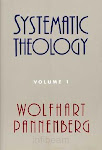2 years ago
Sunday, 14 December 2008
Bernhard Lohse's History of Doctrine (2 of 3)
Lohse's Lutheran lenses
“Augustine emphasized the element of certainty of salvation. Of course, he could not teach this in the way in which Luther did… However, in comparison with the tremendous step forward… such defects a minor” (p. 117, italics added). We are still a thousand years away from the Reformation, but already these early notes hint at what is to come.
Later, the author discusses the theological differences between Luther and Melanchthon. Luther was aware of them, yet, the author explains, “because of his magnanimous disposition, he did not take them seriously except in a few instances” (p. 183, italics added). In vain does one search for signs of premeditated irony in this judgment!
Alas, it seems that the true hero of the symphony of the history of dogma is impervious to criticism: “The advantage in choosing Luther, of course, is that one then has a theology with, in depth and integrity, is perhaps without equal in the history of the church and in the history of dogma” (p. 184, italics added). Even giants such as Augustine and Thomas Aquinas fall short “in depth and integrity”.
Lohse's anti-Catholicism
Every now and then one of the dissatisfied cords are introduced. Perhaps the most straightforward is: “All the appeals to tradition cannot alter the fact that nowhere does tradition count for less than it does in the Roman church” (p. 211). The reference is, of course, to the three new dogmas formulated by the Roman church: the immaculate conception of Mary (1854), papal infallibility (1870), and the bodily assumption of Mary (1950).
It would be very unfair to say that this is characteristic of the author, but at least as far as Roman Catholicism is concerned he occasionally fails to heed a “magnanimous disposition”. As in the following manner: “Not until the beginning of the sixth century did theologians begin to accept the idea of a bodily assumption of Mary. The leading motive in this connection was the notion that such an assumption would be ‘fitting.’” Then the pun: “On this basis, of course, a multitude of things can be proved” (p. 213).
It would have been only fair to clarify why they thought it was “fitting,” for the main reason, even if false, was (and is) not an arbitrary one. If, as the Roman Catholics believe, Mary was indeed vouchsafed from original sin and its effects on the basis of her son’s merits, Mary ought not to have suffered a bodily death, which, according to traditional theology, was (and is) the result of original sin. In this way, the second Marian dogma follows from the first Marian dogma “fittingly”.
It was, however, the finale of the purported-melody-turned-noise that proved too much to bear. Let what is to follow serve as the finale of my criticism as well.
“It must be pointed out,” says the author, “that Luther, as well as the other Reformers, did not intend to form a new church.” So far, so good. But then:
“Their intention was, rather, to reform the whole church, to cleanse it from ‘papistical’ additions, and to reshape it accordingly to the Word of God. During the sixteenth century this attempt was made at various points. As a whole it was unsuccessful, insofar as the Roman church rejected the Reformation. This is the reason Protestant churches came to be established.” (p. 185-6, italics added.)
Two points must be raised here. Firstly, as the Reformation means, in the last analysis, precisely the “attempt at cleansing of the church from ‘papistical’ additions, and reshaping it according to the Word of God”, the author ends up presenting a meaningless tautology: “As a whole [the Reformation] was unsuccessful, insofar as the Roman church rejected the Reformation.”*
Secondly, how is “This is the reason” to be understood? It clearly connotes certain guilt, and as such is historically a rather one-sided, naive claim. We can easily see how even the pettiest sect can wield such an argument in their favour. If, on the other hand, the pejorative connotation was merely accidental, “reason” remains an ambiguous concept and renders the argument logically problematic.
Part 3 of 3 here.
*I guess if the emphasis in on the Roman church rather than on rejected, the statement is not tautologous.
Subscribe to:
Post Comments (Atom)







No comments:
Post a Comment